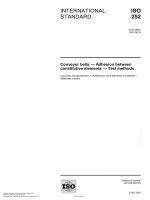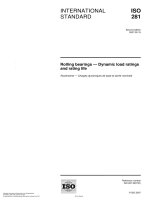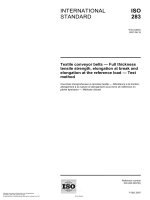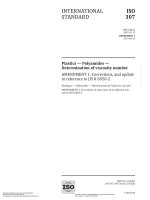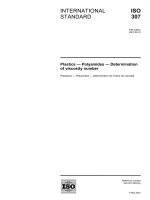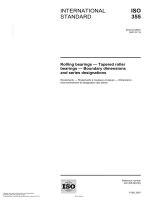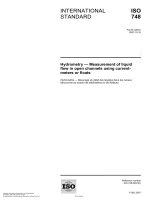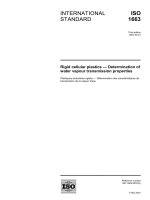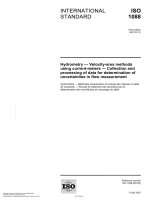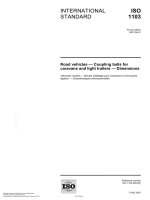Tiêu chuẩn iso 00252 2007
Bạn đang xem bản rút gọn của tài liệu. Xem và tải ngay bản đầy đủ của tài liệu tại đây (198.69 KB, 12 trang )
INTERNATIONAL
STANDARD
ISO
252
Third edition
2007-06-15
Conveyor belts — Adhesion between
constitutive elements — Test methods
--`,,```,,,,````-`-`,,`,,`,`,,`---
Courroies transporteuses — Adhérence entre éléments constitutifs —
Méthodes d'essai
Reference number
ISO 252:2007(E)
Copyright International Organization for Standardization
Provided by IHS under license with ISO
No reproduction or networking permitted without license from IHS
© ISO 2007
Not for Resale
ISO 252:2007(E)
PDF disclaimer
This PDF file may contain embedded typefaces. In accordance with Adobe's licensing policy, this file may be printed or viewed but
shall not be edited unless the typefaces which are embedded are licensed to and installed on the computer performing the editing. In
downloading this file, parties accept therein the responsibility of not infringing Adobe's licensing policy. The ISO Central Secretariat
accepts no liability in this area.
Adobe is a trademark of Adobe Systems Incorporated.
Details of the software products used to create this PDF file can be found in the General Info relative to the file; the PDF-creation
parameters were optimized for printing. Every care has been taken to ensure that the file is suitable for use by ISO member bodies. In
the unlikely event that a problem relating to it is found, please inform the Central Secretariat at the address given below.
COPYRIGHT PROTECTED DOCUMENT
© ISO 2007
All rights reserved. Unless otherwise specified, no part of this publication may be reproduced or utilized in any form or by any means,
electronic or mechanical, including photocopying and microfilm, without permission in writing from either ISO at the address below or
ISO's member body in the country of the requester.
ISO copyright office
Case postale 56 • CH-1211 Geneva 20
Tel. + 41 22 749 01 11
Fax + 41 22 749 09 47
Web www.iso.org
Published in Switzerland
--`,,```,,,,````-`-`,,`,,`,`,,`---
ii
Copyright International Organization for Standardization
Provided by IHS under license with ISO
No reproduction or networking permitted without license from IHS
© ISO 2007 – All rights reserved
Not for Resale
ISO 252:2007(E)
Foreword
ISO (the International Organization for Standardization) is a worldwide federation of national standards bodies
(ISO member bodies). The work of preparing International Standards is normally carried out through ISO
technical committees. Each member body interested in a subject for which a technical committee has been
established has the right to be represented on that committee. International organizations, governmental and
non-governmental, in liaison with ISO, also take part in the work. ISO collaborates closely with the
International Electrotechnical Commission (IEC) on all matters of electrotechnical standardization.
International Standards are drafted in accordance with the rules given in the ISO/IEC Directives, Part 2.
The main task of technical committees is to prepare International Standards. Draft International Standards
adopted by the technical committees are circulated to the member bodies for voting. Publication as an
International Standard requires approval by at least 75 % of the member bodies casting a vote.
Attention is drawn to the possibility that some of the elements of this document may be the subject of patent
rights. ISO shall not be held responsible for identifying any or all such patent rights.
ISO 252 was prepared by Technical Committee ISO/TC 41, Pulleys and belts (including veebelts),
Subcommittee SC 3, Conveyor belts.
This third edition of ISO 252 cancels and replaces ISO 252-1:1999, of which it constitutes a technical revision.
It also incorporates the Technical Corrigendum, ISO 252-1:1999/Cor. 1:2006.
--`,,```,,,,````-`-`,,`,,`,`,,`---
iii
© ISO for
2007
– All rights reserved
Copyright International Organization
Standardization
Provided by IHS under license with ISO
No reproduction or networking permitted without license from IHS
Not for Resale
--`,,```,,,,````-`-`,,`,,`,`,,`---
Copyright International Organization for Standardization
Provided by IHS under license with ISO
No reproduction or networking permitted without license from IHS
Not for Resale
INTERNATIONAL STANDARD
ISO 252:2007(E)
Conveyor belts — Adhesion between constitutive elements —
Test methods
1
Scope
This International Standard specifies two test methods, A and B, for determining the adhesion strength
between constitutive elements of a conveyor belt, i.e. between plies and between covers and carcass. Basic
test conditions are in conformity with ISO 36.
It is applicable to all types of construction of conveyor belting with the exception of belts containing steel cord
reinforcement, and textile-reinforced belts with a full-thickness tensile strength of less than 160 N/mm. It is not
suitable or valid for light conveyor belts as described in ISO 21183-1[1].
NOTE
Methods A and B are alternative options, but the mean adhesive force values calculated for the two methods
can be different. Also, as both methods might not be equally suitable for all belt constructions, it is advisable that the
advice of the belt manufacturer be sought.
2
Normative references
The following referenced documents are indispensable for the application of this document. For dated
references, only the edition cited applies. For undated references, the latest edition of the referenced
document (including any amendments) applies.
ISO 36, Rubber, vulcanized or thermoplastic — Determination of adhesion to textile fabrics
ISO 6133, Rubber and plastics — Analysis of multi-peak traces obtained in determinations of tear strength
and adhesion strength
ISO 18573, Conveyor belts — Test atmospheres and conditioning periods
3
Principle
The mean force required to strip the covers from the carcass, and also each ply from the next, is determined
using a constant rate of traverse machine.
4
Apparatus
Suitable power-driven tensile testing machine, conforming to ISO 36.
5
5.1
Test pieces
Time between manufacture and test
The time between completion of production and the commencement of testing shall be not less than 24 h; this
period shall include the conditioning periods given in 5.5.
--`,,```,,,,````-`-`,,`,,`,`,,`---
1
© ISO 2007 – All rights reserved
Copyright International Organization for Standardization
Provided by IHS under license with ISO
No reproduction or networking permitted without license from IHS
Not for Resale
ISO 252:2007(E)
5.2
Shape and dimensions
Each test piece shall consist of a strip of belting of rectangular cross-section with clean-cut edges,
(25 ± 0,5) mm wide and 200 mm minimum in length, so as to permit a length of at least 100 mm to be stripped.
If necessary and where possible, the thickness shall be reduced to a value which will ensure that during the
test the line of separation remains as near as possible to the plane through the axes of the components of the
test piece held between the grips (see Figure 1).
The minimum thickness shall be such that the weakest component can transmit the necessary force for
separation without breaking.
Key
1
plane through axes of components of test piece held between grips
2
line of separation (correct alignment with plane through axes)
3
line of separation (incorrect alignment with plane through axes)
4
test piece with reduced thickness to improve alignment
Figure 1 — Position of line of separation of plies
Number
For both methods, A and B, two test pieces in the longitudinal direction shall be used.
The test may also be conducted with two transverse test pieces, if agreed between the manufacturer and
purchaser.
2
Copyright International Organization for Standardization
Provided by IHS under license with ISO
No reproduction or networking permitted without license from IHS
© ISO 2007 – All rights reserved
Not for Resale
--`,,```,,,,````-`-`,,`,,`,`,,`---
5.3
ISO 252:2007(E)
5.4
Selection of test pieces from sample
The test pieces shall be taken not less than 100 mm from the edges of the available belt sample and from
places as widely spaced as possible.
5.5
Conditioning
Condition the test pieces in accordance with ISO 18573, using either atmosphere D or atmosphere E, and
then carry out the tests immediately after completion of the conditioning period.
6
--`,,```,,,,````-`-`,,`,,`,`,,`---
6.1
Procedure
Method A (see Figure 2)
At one end of the longitudinal test piece, separate the top cover from the first ply for a distance appropriate to
the test grips to be used. Fix the separated ends in the grips of the tensile testing machine and make an
autographic record of the force required to strip a further 100 mm with a rate of traverse of the driven jaw of
(100 ± 10) mm/min. The test piece shall be unsupported.
Repeat this procedure using the same test piece for each consecutive ply up to the middle of the test piece.
Carry out a similar series of tests on a second longitudinal test piece but commencing with the bottom cover.
If the test is to be carried out on transverse test pieces, conduct the test in the same manner.
Any separation occurring outside the plane of contact between the two components, for example, inside one
of the components (such as a cover) subjected to the test, is considered as a rupture of the material which
constitutes the component. Such a separation should be noted, but should not be considered as
representative of the adhesion strength.
3
© ISO 2007 – All rights reserved
Copyright International Organization for Standardization
Provided by IHS under license with ISO
No reproduction or networking permitted without license from IHS
Not for Resale
ISO 252:2007(E)
--`,,```,,,,````-`-`,,`,,`,`,,`---
Key
1
top cover
2
bottom cover
Figure 2 — Sequence of separation of components for method A (5-ply belt shown as example)
4
Copyright International Organization for Standardization
Provided by IHS under license with ISO
No reproduction or networking permitted without license from IHS
© ISO 2007 – All rights reserved
Not for Resale
ISO 252:2007(E)
6.2
Method B (see Figure 3)
--`,,```,,,,````-`-`,,`,,`,`,,`---
At one end of the longitudinal test piece, separate the top cover from the first ply for a suitable distance
appropriate to the test grips to be used. Fix the separated ends in the grips of the tensile testing machine and
make an autographic record of the force required to strip a further 100 mm with a rate of traverse of the driven
jaw of (100 ± 10) mm/min. The test piece shall be unsupported.
Key
1
top cover
2
bottom cover
Figure 3 — Sequence of separation of components for method B (5-ply belt shown as example)
5
© ISO 2007 – All rights reserved
Copyright International Organization for Standardization
Provided by IHS under license with ISO
No reproduction or networking permitted without license from IHS
Not for Resale
ISO 252:2007(E)
Repeat this procedure using the same test piece, stripping consecutively two unseparated plies from the
remainder of the test piece.
Carry out a similar series of tests on a second longitudinal test piece but commencing by separating the
unseparated top cover and first ply from the second ply.
If the test is to be carried out on transverse test pieces, conduct the test in the same manner.
Any separation occurring outside the plane of contact between the two components, for example, inside one
of the components (such as a cover) subjected to the test, is considered as a rupture of the material which
constitutes the component. Such a separation should be noted, but should not be considered as
representative of the adhesion strength.
7
7.1
Expression of results
Examination of traces for longitudinal test pieces
Examination and analysis of the multi-peak adhesion strength test traces shall be in accordance with
ISO 6133. The median peak force is defined as the mean adhesion force. The lowest graphically recorded
peak is defined as the minimum adhesion force.
Calculate the mean adhesion as the quotient of the mean adhesion force, in Newtons, divided by the nominal
width, in millimetres, of the test piece to the nearest 0,1 N/mm.
Calculate the minimum adhesion as the quotient of the minimum adhesion force, in Newtons, divided by the
nominal width, in millimetres, of the test piece to the nearest 0,1 N/mm.
7.2
Examination of traces for transverse test pieces
Make calculations in accordance with 7.1 for the two test pieces cut transversely, if applicable.
8
Test report
The test report shall contain the following information:
a)
reference to this International Standard (i.e. ISO 252);
b)
identification of the conveyor belt tested;
c)
time interval between belt manufacture and test piece preparation;
d)
temperature and times for conditioning and testing;
e)
test method used (A or B);
f)
mean adhesion, as calculated in accordance with 7.1, for the top cover to ply or carcass measurement,
the bottom cover to ply or carcass measurement and for each ply to ply measurement;
g)
minimum adhesion, as calculated in accordance with 7.1, for the top cover to ply or carcass measurement,
the bottom cover to ply or carcass measurement and for each ply to ply measurement;
h)
any case where one of the components fails before the adhesion strength between the two components
is reached, and the force at which the failure occurred (see final paragraph of 6.1 and 6.2);
i)
date of the test.
6
Copyright International Organization for Standardization
Provided by IHS under license with ISO
No reproduction or networking permitted without license from IHS
--`,,```,,,,````-`-`,,`,,`,`,,`---
Not for Resale
© ISO 2007 – All rights reserved
ISO 252:2007(E)
Bibliography
ISO 21183-1, Light conveyor belts — Part 1: Principal characteristics and applications
--`,,```,,,,````-`-`,,`,,`,`,,`---
[1]
7
© ISO 2007 – All rights reserved
Copyright International Organization for Standardization
Provided by IHS under license with ISO
No reproduction or networking permitted without license from IHS
Not for Resale
--`,,```,,,,````-`-`,,`,,`,`,,`---
ISO 252:2007(E)
ICS 53.040.20
Price based on 7 pages
© ISO 2007 – All rights reserved
Copyright International Organization for Standardization
Provided by IHS under license with ISO
No reproduction or networking permitted without license from IHS
Not for Resale
